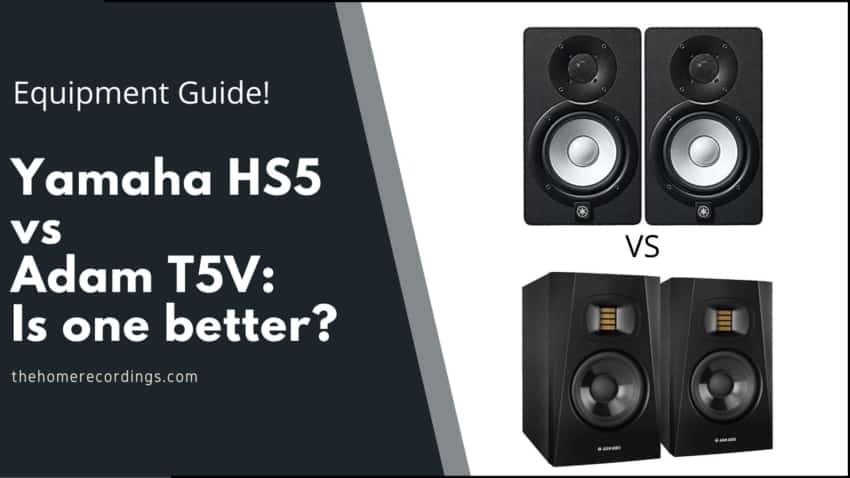Last updated on December 30th, 2023 at 02:57 pm
The Yamaha HS5 and the Adam Audio T5V are two of the most common budget studio monitors you can find, and while they do have their flaws, they are overall great studio monitors, especially considering their price.
In this article, I will be comparing them both, giving you a brief overview of their overall features, build quality and sound quality, and at the end I’ll give you my recommendation.
So, without any further ado, let’s get started!
Differences between the Yamaha HS5 and Adam T5V studio Monitors
The main difference between the Yamaha HS5 and the Adam T5V monitors lies in their tweeter, since the Adam T5V has a ribbon tweeter which is better at reproducing the high end than the one on the Yamaha. Aside from that, the Yamaha HS5 have a more pronounced mid range.
These are extremely similar monitors in almost every way, both from how they are constructed to their overall sound quality.
Let’s take a quick look at each specific monitor before I tell you which one I would go with.
Yamaha HS5
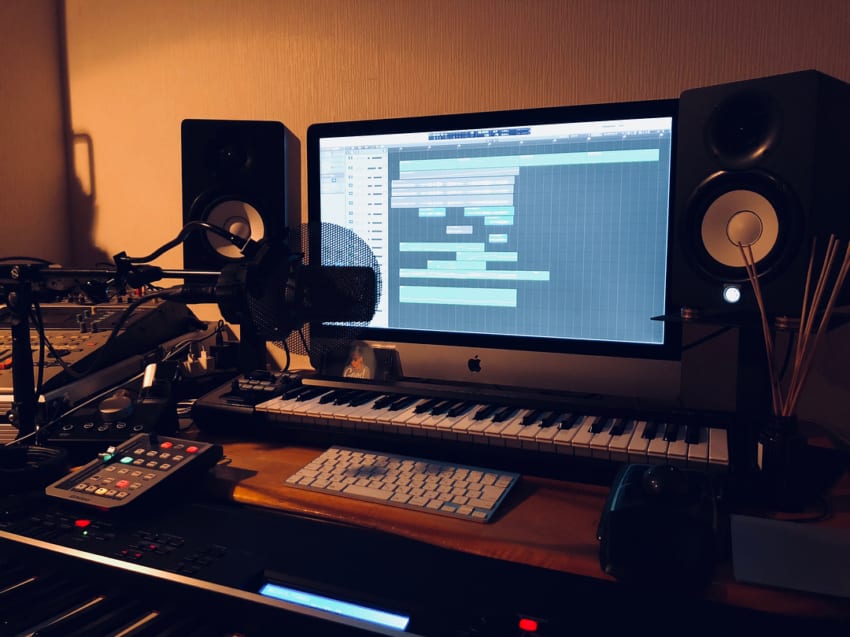
The Yamaha HS5 are near-field monitors with a 5” woofer and a 1” tweeter. Their bigger brother, the HS8’s, have been an industry standard for years now, but not because of how great or flat they sound, but because they accentuate problematic areas in the mix (mids and upper mids), which allows you to have a more critical listen of those frequencies to be able to fix them.
Essentially, if a mix sounds great on the Yamaha HS5’s, 7’s or 8’s, it sounds great anywhere!
The HS5’s, just the like Adam T5V, have the bass reflex port on the back instead of the front, which is something that other monitors, such as the Kali LP-6, have on the front, and don’t feature too much control over their sound signature to properly set them up in your specific room.
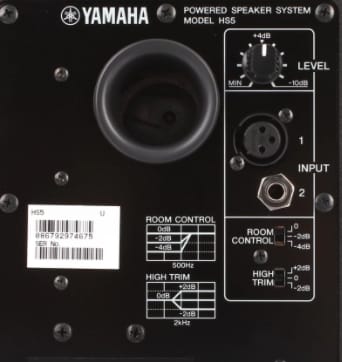
To do this, you only get two +2/-2dB High- and low-mid frequency switches called Room Control and High Trim, but that’s it!
Lastly, they have a frequency response of 54Hz to 30kHz.
Build Quality
The Yamaha HS5 are superbly built: They feel extremely rugged, are quite heavy, and the level control knob doesn’t have any wiggle to it. So, they should last you for a very long time.
Connectivity
- 1x XLR.
- 1x TRS.
Note: No RCA.
Sound Quality
The Yamaha HS5 monitors are not known for sounding flat or balanced. In fact, their upper mid-range is a bit exaggerated.
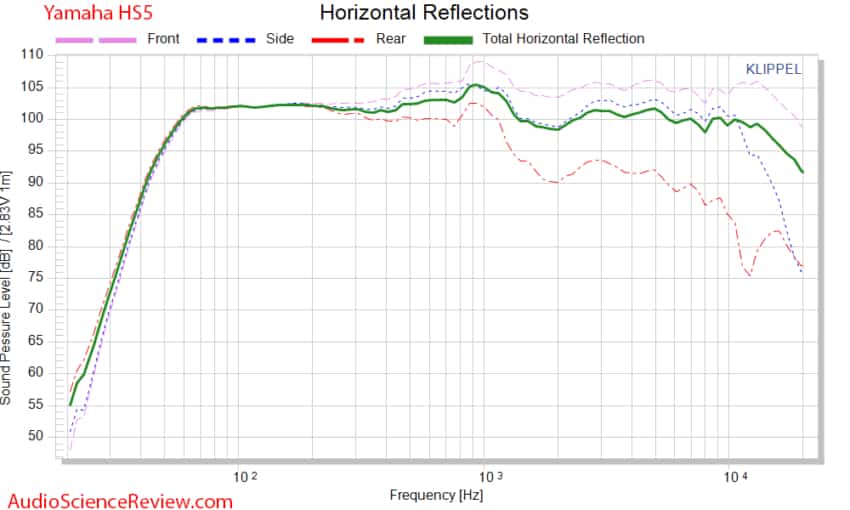
This can actually be quite useful when mixing music where a lot of instruments are in that mid- and upper-mid range, since these monitors help you identify more problems in that specific area, which tends to have a lot of issues, especially in modern pop music, and you can use them to more easily make room for all the instruments, vocals, etc.
It’s worth noting that since these are 5” monitors, the low end won’t be as present as with larger monitors.
For music production, general music listening, watching movies, etc., they work really well, but remember that the low end might not be as prominent as the mids and highs and therefore they might sound a little more hyphy to you than other monitors.
Price Tag
Generally speaking, the Yamaha HS5 monitors are a bit more affordable than the Adam T5V, and their price seems to be dropping a little as well, at least from what I’ve seen.
You should be able to get a pair for about $400, so $200 each.
- You can get the Yamaha HS5 here: Amazon, Sweetwater.
Both of these monitors are part of my list of the best Studio Monitors under $300 that you should also check out!
Adam Audio T5V
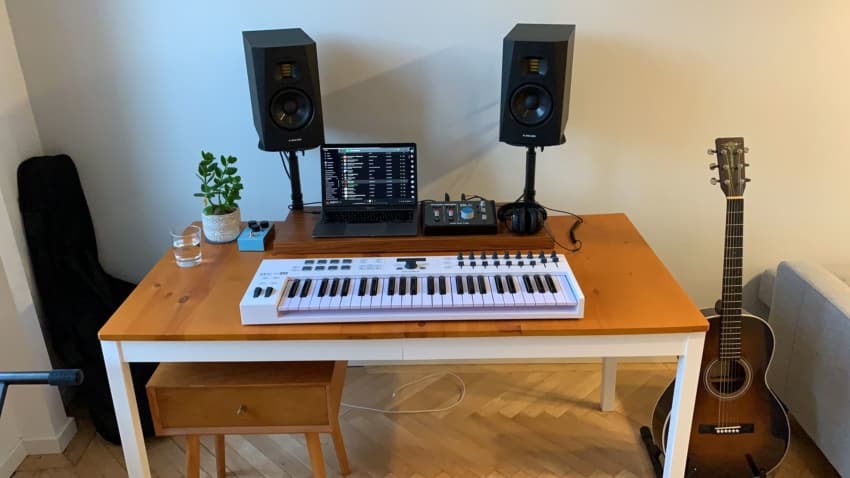
I used the T5V’s a couple times, and while I don’t have as much experience and time invested into them as I do with other monitors, I do have a pretty good idea on how they perform.
Now, just like with the HS5’s, the T5V monitors have 5” woofers, and this means that they aren’t able to reproduce the low end as well as some larger monitors, so always keep that in mind.
As far as the tweeter goes, this is where the T5Vs shine since it’s a ribbon-style tweeter that is excellent at accurately reproducing the high-end, and in this regard, I do have to say that they are better than the Yamaha monitors, but more on sound quality in a second.
As far as size in concerned, which is something I didn’t previously touched on when talking about the Yamaha monitors, the Adam T5V are a bit larger but not by much, so this shouldn’t really affect your decision.
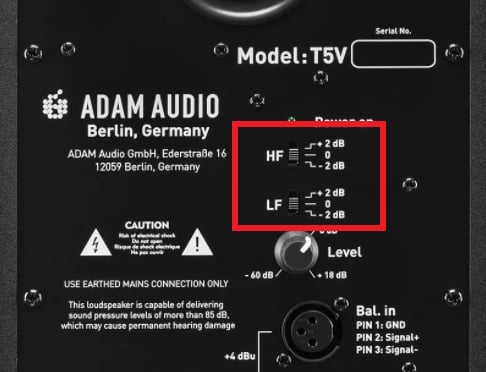
On the back, they also have a level control as well as the same two 3-way switches labeled “LF” and “HF” that boost or cut the monitor’s respective high- and low-frequency responses by 2dB (pretty lame if you ask me, especially since there are similarly-priced monitors that offer a lot more control over the sound signature, such as the Kali LP-6 and the KRK Rokit 5 G4).
They also have a frequency response of 45Hz to 25kHz.
Build Quality
The build quality is identical to the one of the Yamaha HS5: They are very well put together, are quite heavy as well, and should absolutely last you a very long time if properly taken care of.
Connectivity
- 1x XLR.
- 1x RCA.
Note: No TRS.
As you can see, these monitors don’t offer a TRS connection, which means that you will either have to connect them XLR to XLR, if your audio interface has XLR outputs, or use a TRS to XLR cable.
Sound Quality
As far as the high end goes, the T5V sound phenomenal and it’s definitely where they excel at.
However, the lower end is a bit lacking and all of this makes it so that they don’t sound as balanced, or as flat in general.
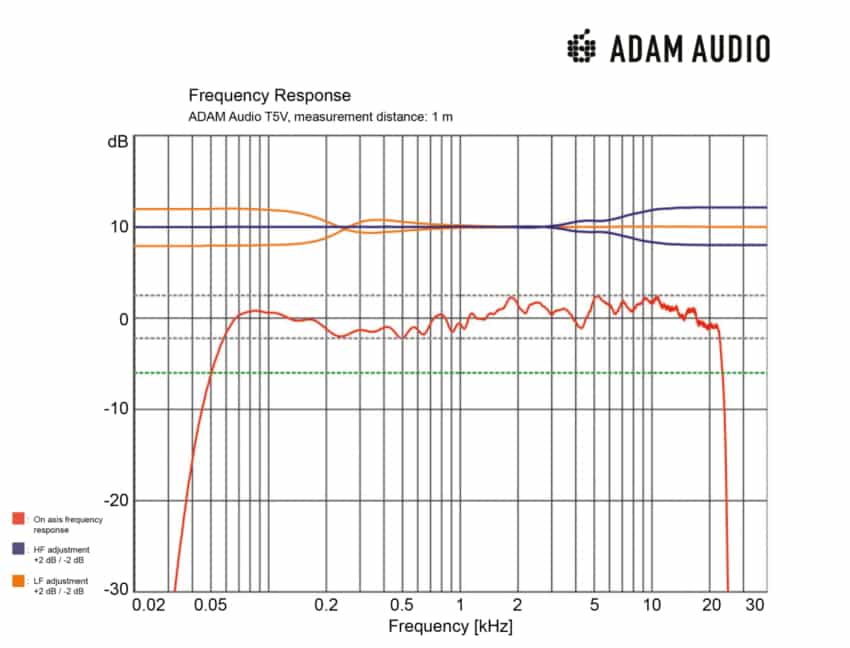
However, at least to my ears, they sound a bit more balanced than the Yamaha NS5, although not by much, with the high-end sounding a bit cleaner.
For mixing music, general music listening, watching movies, etc., they do work quite well.
Price Tag
The Adam T5V are a bit pricier than the Yamaha HS5’s, about 10% more expensive, and you should be able to get them for about $220 depending on where you buy them.
- You can get the Adam T5V here: Amazon, Sweetwater.
Overall Impressions & recommendation
These are very similar monitors no matter how you look at them: They have a 5” woofer, are a bit lacking in the bass department, the EQ switches on the back aren’t all that useful since they don’t allow you to properly adjust the sound signature, etc.
I would go with the cheapest one you can find, to be honest. However, if they are available for exactly the same price, then I would personally choose the Yamaha monitors since the increased mid- high-end should help you produce music better more easily.
I hope this information was useful!
Have a wonderful day!
